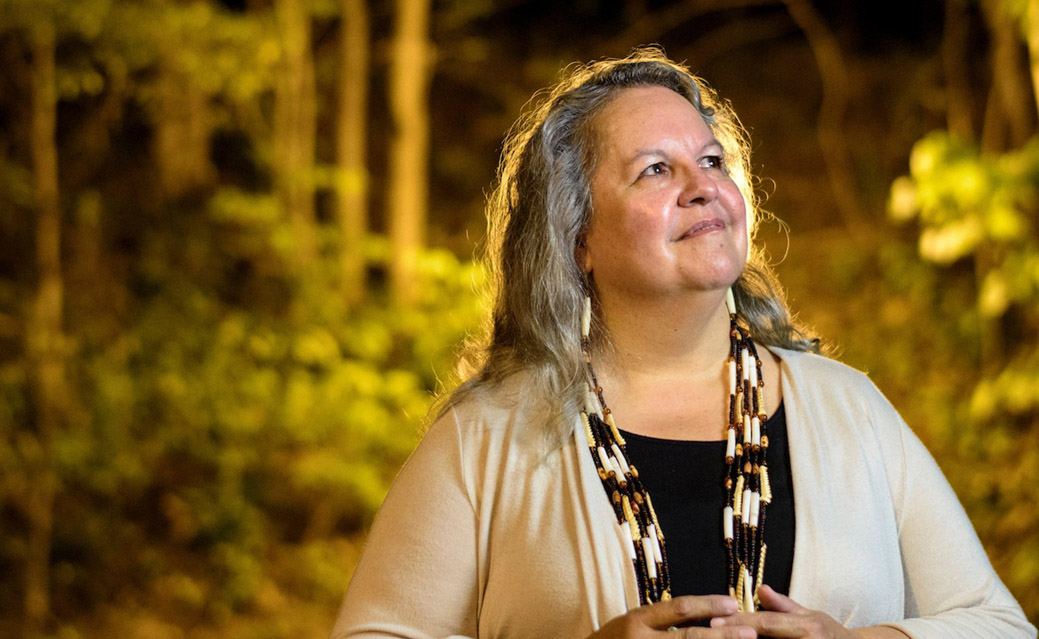The 2021 Snider Lecture: It’s time to restore humanity’s relationship with the natural world
Robin Wall Kimmerer discusses the importance of healing our land through an Indigenous lens.
On October 4, Robin Wall Kimmerer presented her talk titled “Restoration and Reciprocity” at the annual University of Toronto Mississauga (UTM) Snider Lecture—an event aimed to enrich the intellectual and cultural life of the community. In her presentation, Kimmerer discusses the importance of restoring nature’s well-being and our relationship with the environment.
Kimmerer is a writer, a distinguished professor of environmental biology at the State University of New York, and the founder of the Centre for Native Peoples and the Environment. Her books Gathering Moss: A Natural and Cultural History of Mosses and Braiding Sweetgrass have gained numerous appraisals for exceptional nature writing. She is also a member of the Citizen Potawatomi Nation, a federally recognized government that represents more than 37,000 tribal members.
She prefaces the lecture by reminding us that we keep on asking “what more can we take from the Earth?” instead of “what does the Earth ask of us?” Kimmerer explains that through the human exceptionalism mindset, we tend to view land as a commodity—rather than a sustainer, a moral responsibility, a source of knowledge, a healer, and most importantly, a home. She emphasizes the need for wisdom outside of the Western peripheral.
In the Indigenous paradigm, learning stems from many different sources, one of which is plants. In Indigenous lessons, plants are the oldest teachers as they can take light, water, and air to nourish themselves. They later give these elements away for other beings to consume. Plants are the largest and most powerful of our relatives; they tell us stories through their actions rather than words.
We often see solutions to climate change aligned with the development of new technologies, as opposed to nature-based solutions. Kimmerer takes the example of Richard Branson’s Virgin Earth Challenge, where engineers are challenged to design technology that extracts and deposits the carbon in our atmosphere with a reward of $25 million. Kimmerer states that we do not need new technology to eliminate carbon when forests have been doing that for us all along. “[Forests] generate oxygen, build soil, protect biodiversity, and purify water at the same time,” she explains. “They make us happy and peaceful. [Plants] don’t ruin the land, they heal the land.”
While Kimmerer invites us to align our thinking with plants and join the movement to “keep it in the ground,” it is not to say that nature can do its work alone. She explains that plants have become more futile, with less nutrients and water due to climate change: “We have crippled the plants’ ability to do their jobs, which is why they need our help.” Kimmerer suggests that nature-based solutions to halting climate change must be as strong as technology-based solutions. She refers to biomimicry, a technological approach that focuses on implementing nature’s practices.
To strive for a sustainable future, Kimmerer argues that we need a change in the system. “The average American can recognize 100 different corporate logos but can only recognize ten types of plants,” she states. “It is no surprise that we live in a society where corporations are granted rights of personhood, but living beings are not.” She emphasizes that “knowing the beings with whom we share the [planet] with is a pathway to recognition to the world as a precious gift.”
Kimmerer ends the lecture with a story of hope and courage in times of crisis. First hearing it from Tom Porter, a Haudenosaunee Elder, the story follows the conflict between the twin grandsons of Sky Woman—the Indigenous mother goddess that descended from the sky to play an important role in the creation of the Earth—and all living beings. Sky Woman represents the forces of creation and destruction, as they decide on the future of the world through the “peach stone game.”
In the peach stone game, players use a set of “stones” (often peach pits), where one side of the seed is painted white and the other black. The stone is then put in a bowl to be shaken and thrown in the air. The winner is determined if all the seeds come up with the same color. If all the stones come up black, destruction will rule the Earth. If all the stones come up white, the world continues to thrive under “the generous hand of creation.”
One by one, the stones landed back in the bowl, and each of them came up black. All the creations, as narrated by Kimmerer, “the trees, the berries, the grasses, the four-legged, the many-legged, the no-legged” held in their breath as the last seed made its way down to the bowl. They used their voices to shout so loud that it overruled human foolishness and turned the last stone white.
As Kimmerer puts it, “it was the mighty shout of creation that saved the beautiful world. But we gamble again with the fate of the Earth. All this time they have stood for us, and we have paid them with betrayal and silence as destruction reigned. Now, it is we as humans who must give the mighty shout.”

